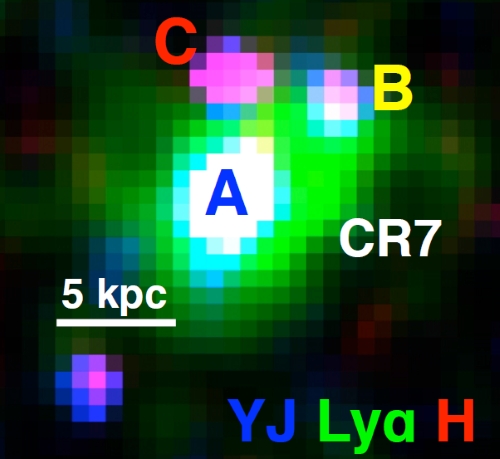
A galaxy far away: this false colour image of CR7 was taken by several telescopes. (Courtesy: David Sorbal et al.)
By Hamish Johnston
Over the past decade or so the Real Madrid football club has acquired a string of high profile players dubbed the “Galácticos”. Now the most expensive of these footballers – the Portuguese forward and Real Madrid number 7 Cristiano Ronaldo – has a distant galaxy named after him. The galaxy is dubbed “CR7” and was discovered by a team of astronomers led by David Sobral of the University of Lisbon using several different telescopes.
CR7 actually has two meanings, the second being “COSMOS Redshift 7”. COSMOS refers to the Cosmological Evolution Survey, which is using a number of telescopes to search for very old galaxies.
We see the galaxy as it was just 900 million years after the Big Bang (at a redshift of 7) and it seems to comprise extremely bright stars that are made almost entirely of hydrogen and helium. This is unlike modern stars like the Sun, which contain a range of heavier elements. These ancient stars are believed to have been short lived and exploded after a few hundred million years to create the seeds of the heavy elements found throughout the universe. You can read more about the physics of Cristiano Ronaldo 7 in this preprint, which has been accepted for publication in The Astrophysical Journal: “Evidence for Pop III-like stellar populations in the most luminous Lyman-α emitters at the epoch of re-ionisation: spectroscopic confirmation”.
Astronomy and popular culture have also crossed paths this week in New York’s Times Square, where on 14 August 1945 Alfred Eisenstaedt took the famous photograph “V-J Day in Times Square”. The photo shows a sailor and a nurse kissing but their faces are partially obscured – and as a result a number of different people have claimed to be Eisenstaedt’s subjects over the years.
Now a team of astronomers led by Donald Olson of Texas State University and Steve Kawaler of Iowa State University have analysed the shadows in the photograph and worked out the time of day when it was taken. According to this article in the New York Times, Eisenstaedt’s shutter snapped at 5:51 p.m. and this seems to rule out George Mendonsa and Greta Zimmer as the couple in the photo. The pair are the subject of the book The Kissing Sailor, which claims to offer “irrefutable proof” that Mendonsa and Zimmer are in the photo. The only problem is that Mendonsa and Zimmer say they kissed at around 2:00 p.m.
The Sun is also 98.7% hydrogen and helium whose distribution leads to its form to be highly spherical and effects its spin rate that varies from the equater to the poles.